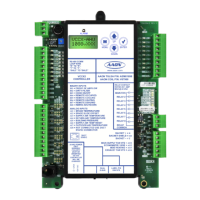34VCCX2 Controller Technical Guide
SEQUENCE OF OPERATIONS
Modes of Operation
Primary Modulating Heat with Secondary Staged Heat
The modulating heat source can be modulating gas, modulating
hot water, modulating steam, or SCR electric heat. In this case the
modulating heat will be the rst form of heat used and will attempt
to achieve the active Supply Air Heating Setpoint. If the modulating
heat reaches 100%, the heating stage up delay begins. If the primary
heat source is still at 100% after the heating stage up delay expires,
the secondary heat source will activate. The primary heat source can
then modulate as necessary to achieve the active Supply Air Heating
Setpoint. If there are additional stages of heat, they will stage up as
described, with the primary heat source modulating as necessary.
If the secondary heat source is activated and the primary heat source
has modulated to 0%, the heating stage down delay will begin. If
the primary heat source is still at 0% after the heating stage down
delay expires, the secondary heat source will deactivate. If there are
multiple stages of secondary heat, they will stage o in the same
manner. Then, if the supply air temperature rises above the active
Supply Air Heating Setpoint plus the heating stage control window,
the primary heat source will modulate to 0% to allow the supply air
temperature to cool o.
Hot Water Coil Protection
NOTE: Unless the following sequence is utilized, the hot
water valve is closed (regardless of conguration)
when not being used for heating.
Fan On Mode
If anytime the fan is on, the supply air temperature falls below the
user-adjustable Low Supply Air Temperature Cuto Setpoint for at
least one minute, the hot water valve will move to a user-adjustable
position congured with the Hot Water Valve Protection Position
Setpoint. If the supply air temperature rises above the low supply
air cuto by 5°F, the valve will return to its normal position.
If the supply air temperature remains below the Low Supply Air
Temperature Cuto Setpoint for 10 minutes, the unit will then
shut down and the low supply air temperature cuto alarm will be
generated. If the supply air temperature rises above the low supply
air cuto by 5°F, the alarm (if generated) will clear and the unit
will attempt to restart and resume normal operation.
Fan O Mode
If anytime the fan is o, the outdoor air temperature falls below
the user-adjustable Low Ambient Setpoint, the hot water valve will
move to the user-adjustable Hot Water Valve Protection Position
Setpoint. If the outdoor air temperature rises above the Low Ambient
Setpoint, the valve will return to its normal position.
If the Hot Water Valve Protection Position Setpoint is left at the
default of 0%, the controller will not initiate this protection sequence.
This operation works during emergency shutdown.
Vent Mode
This mode is only available in the Occupied Mode of operation
on units congured for continuous supply fan operation and is
generated anytime there is no demand for heating or cooling. The
fan will operate at the congured minimum vent speed.
Dehumidication Mode
On VAV, CAV, single VAV, and high percentage outdoor units with
space temperature control, the Dehumidication Mode is initiated
when the indoor humidity or dewpoint rises above the Indoor
Humidity or dewpoint High Reset Source Setpoint. The unit will
leave the Dehumidication Mode when the humidity or dewpoint
falls below the Indoor Humidity or Dewpoint Low Reset Source
Setpoint.
On 100% outdoor air (MUA) units with outdoor air temperature
control, Dehumidication is initiated when the outdoor air dewpoint
rises above the Outdoor Air Dewpoint Setpoint by 2°F. The unit
will leave the Dehumidication Mode when the dewpoint falls 2°F
below this setpoint. The outdoor air dewpoint is calculated using
the outdoor air temperature and the outdoor air humidity.
Occupied Vent Mode Only
Dehumidication can only be initiated in the Occupied Mode
when there is no call for Heating or Cooling. This creates a Vent
Dehumidication Mode.
Both Occupied and Unoccupied Vent Mode
Dehumidication can be initiated in the Occupied and Unoccupied
Modes when there is no call for Heating or Cooling. This creates a
Vent Dehumidication Mode.
All Modes while Occupied
Dehumidication can be initiated anytime in the Occupied Mode
during Cooling, Heating, or Vent Mode. This can create a Cooling
Dehumidication Mode, a Heating Dehumidication Mode, or a
Vent Dehumidication Mode.
All Modes while Occupied and Unoccupied
Dehumidication can be initiated anytime in the Occupied or
Unoccupied Mode during Cooling, Heating, Vent, or O Mode.
This can create a Cooling Dehumidication Mode, a Heating
Dehumidication Mode, or a Vent Dehumidication Mode. Any calls
for Unoccupied Dehumidication use the same Dehumidication
Setpoint as during the Occupied Mode.
NOTE: Do not use this option on a MUA unit that does not
have return air and which is not congured for space
controlled night setback operation. Damage to the
unit could occur since the outdoor air damper remains
closed in the Unoccupied Mode.

